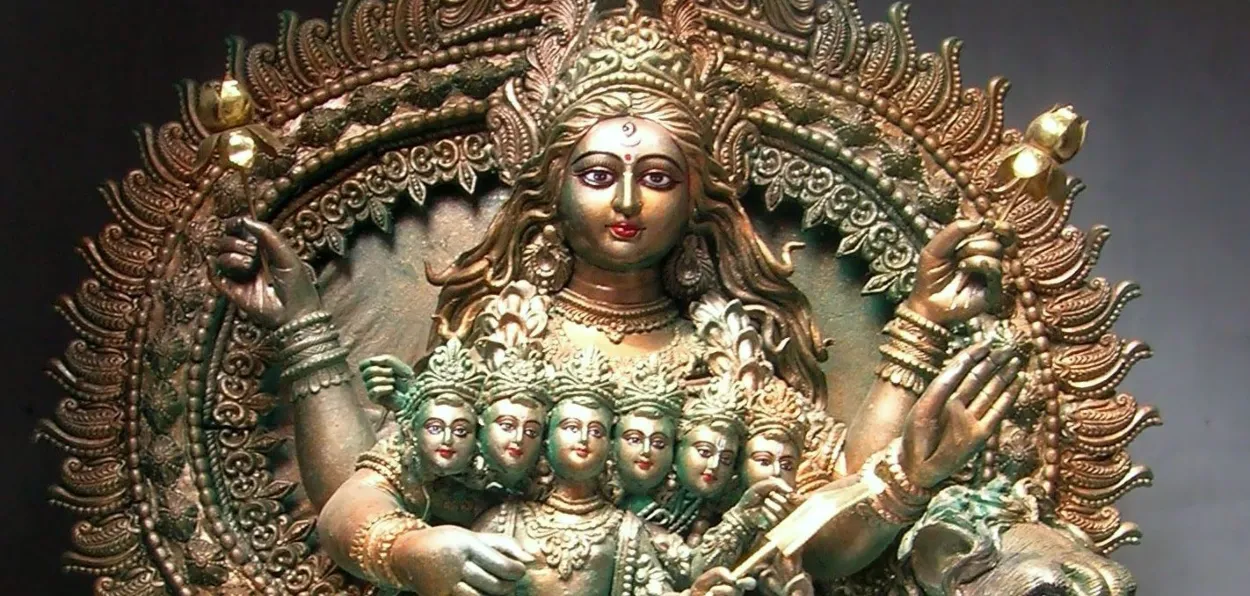
Vidushi Gaur
Navratri, the nine-day festival of the Goddess, is celebrated with devotion and diverse customs across India. Each day honours a different form of Durga, symbolising distinct aspects of feminine energy.
The fifth day of Navratri is dedicated to Goddess Skandamata, revered as the motherly form of Shakti who grants wisdom, prosperity, and salvation. In Uttar Pradesh, Navratri traditions blend temple rituals, fasting, community gatherings, and folk practices, making this day a vibrant expression of devotion.
Mythological Story of Skandamata
The name Skandamata translates to Mother of Skanda, another name for Kartikeya, the commander-in-chief of the gods’ army. According to the Skanda Purana, when demons like Tarakasura oppressed the heavens, the gods prayed for a saviour. Their prayers were answered when Kartikeya was born to Shiva and Parvati, destined to lead the celestial armies.
Skandamata is depicted with four arms: she carries infant Skanda in her lap, holds lotus flowers in two hands, and keeps one hand in abhaya mudra (gesture of protection). She rides a lion, symbolising courage, but her nurturing pose emphasises compassion and maternal love.
Devotees believe that worshipping Skandamata not only bestows her blessings but also grants the grace of her son Kartikeya. She represents the balance of motherhood and divine strength, the power to protect, nurture, and guide.
Rituals of the Fifth Day
On this day, devotees rise early, bathe, and perform rituals with devotion. The colour of the day is green, symbolising harmony and renewal. Offerings to Skandamata include bananas, sweets made of jaggery, and panchamrit (a mixture of milk, curd, ghee, honey, and sugar). Chanting the Skandamata mantra and verses from the Durga Saptashati is common. Fasting remains an important practice, with many devotees consuming only fruits, milk, or light, sattvic food. Skandamata’s worship is believed to bring peace to households, resolve family disputes, and strengthen relationships, especially between mothers and children.
Celebrations in Uttar Pradesh
Uttar Pradesh, often called the heartland of North India, has a distinctive way of celebrating Navratri. The festival is not just a spiritual event but also a cultural and social gathering that touches every town and village. On the fifth day, worship of Skandamata is performed at home and in temples, but the celebrations have unique features.
In cities like Varanasi, Mathura, Ayodhya, and Lucknow, temples dedicated to Durga and her various forms are thronged by devotees. Priests perform elaborate rituals with chanting, conch blowing, and ringing bells, while devotees offer bananas and flowers to Skandamata. The evening aartis attract large gatherings, with women and children actively participating.
In UP, Navratri fasts are observed with great rigour. Many people consume singhare ka atta (water chestnut flour), kuttu ka atta (buckwheat flour), samak rice, and potatoes prepared in rock salt. Households prepare special delicacies like sabudana khichdi, aloo tikki, and laukiki kheer. After sunset, families gather for collective prayers and then break their fast with these offerings.
Although Kanjak or Kanya Puja is performed on Ashtami or Navami, the preparations often begin by the fifth day. In many households, young girls, symbolising the goddess, are invited, their feet washed, and they are served food and gifts. By the fifth day, families start arranging essentials like halwa, puri, and chana, which will be prepared for the ritual.
In towns and villages, Navratri melas (fairs) are a highlight. Temporary stalls sell sweets, toys, bangles, and devotional items. In rural areas, folk performances, bhajans, and raas-leela enactments bring communities together. These gatherings reinforce the collective spirit of devotion and festivity.
ALSO READ: Durga Puja: The sacred symphony of divine femininity on Earth
In Uttar Pradesh, Navratri is closely tied with Ram Leela performances, especially in Varanasi, Ayodhya, and Kanpur. On the fifth day, these plays, based on the Ramayana, continue to draw crowds. The performances celebrate the victory of good over evil, paralleling the worship of Skandamata, who symbolises maternal power, nurturing the warrior Kartikeya.
